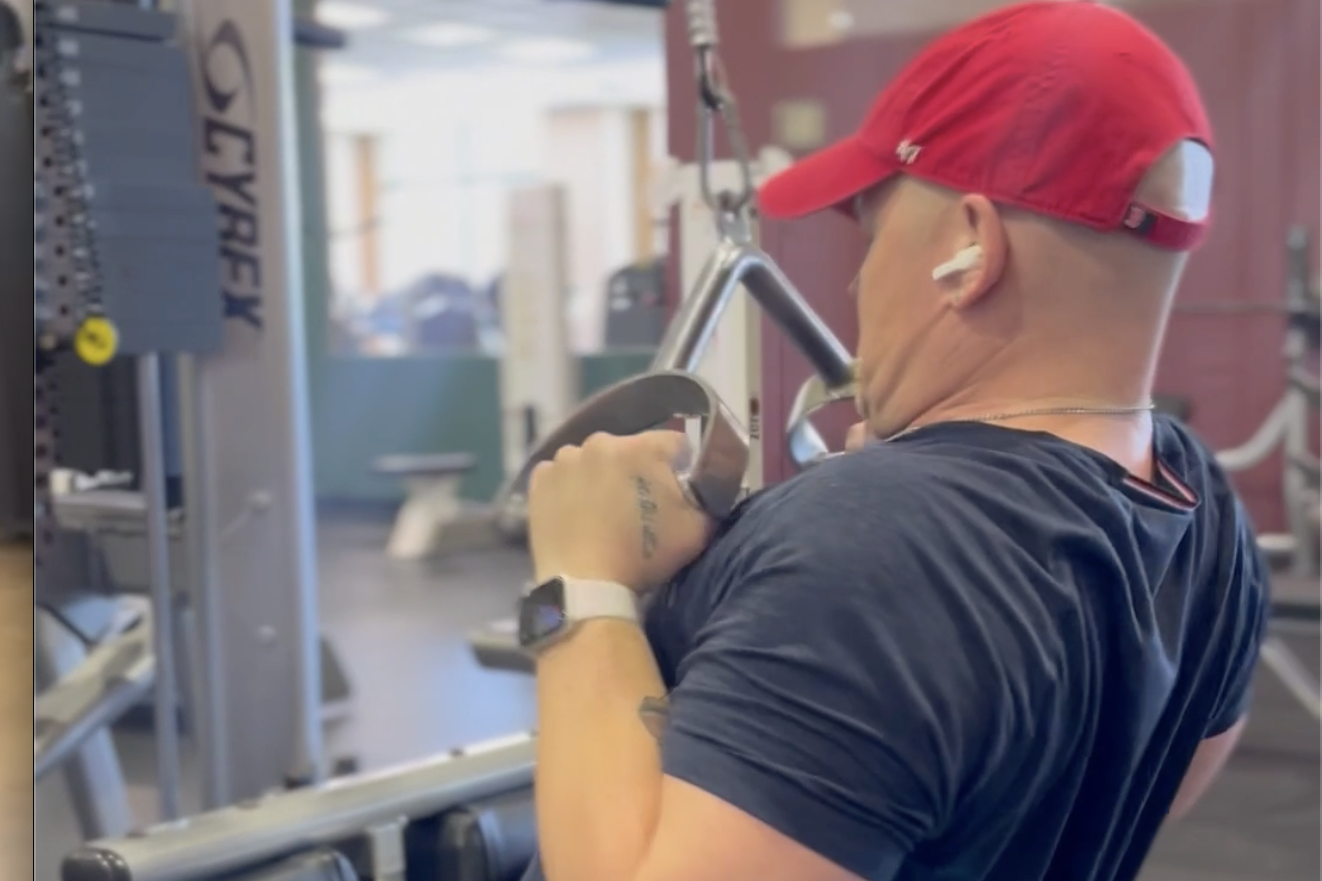Back Workout 2
#BackWorkout
Instructions:
Warm Up
✅ Start with a weight that is easy and does not cause strain or heavy breathing.
Reverse Pyramid
✅ On your first heavy weight: Do a weight that you can do 4-6 reps. Then decrease the weight by 10% for each of the following reps. Once you hit the max you can do, increase your weight. Rinse and repeat as you get stronger.
Rest Pause
✅ Rest Pause is 4 Rounds. The first set is larger and the other three are smaller. The weight stays the same for all rounds. If you can do 12 Reps and 6 Reps with only 15 seconds of rest easily, then increase the Rep count to 14 and 7.
Abs
✅ You have Two Options: Option 1: You can do 1 Set of 60 OR Option 2: 3 Sets of 20 (you can mix it in between the exercises as you do the workout)
The Workout
1. V Bar Pull Down (Reverse Pyramid)
Example: (adjust weight according to what works best for you)
Warm up: 4-6 Reps: 30 pounds (then do 1 minute rest)
Warm up: 4-6 Reps: 40 pounds (then do 2 minute rest)
Round 1 – Do 4-6 Reps: 60 pounds (then do 3 minute rest)
Round 2 – Do 6-8 Reps: 50 pounds (then do 3 minute rest)
Round 3 – Do 8-10 Reps: 40 pounds (then do 3 minute rest)
2. V Bar Pull Down (Rest Pause)
Example: (adjust weight according to what works best for you)
Round 1 – Start at 12 Reps for your first set (then do 15 second rest)
Round 2 – Do 6 Reps (then do 15 second rest)
Round 3 – Do 6 Reps (then do 15 second rest)
Round 4 – Do 6 Reps (then do 15 second rest)
3. Machine Free Weight Row (Reverse Pyramid)
Example: (adjust weight according to what works best for you)
Warm up: 4-6 Reps: 30 pounds (then do 1 minute rest)
Warm up: 4-6 Reps: 40 pounds (then do 2 minute rest)
Round 1 – Do 4-6 Reps: 60 pounds (then do 3 minute rest)
Round 2 – Do 6-8 Reps: 50 pounds (then do 3 minute rest)
Round 3 – Do 8-10 Reps: 40 pounds (then do 3 minute rest)
4. Machine Free Weight Row (Rest Pause)
Example: (adjust weight according to what works best for you)
Round 1 – Start at 12 Reps for your first set (then do 15 second rest)
Round 2 – Do 6 Reps (then do 15 second rest)
Round 3 – Do 6 Reps (then do 15 second rest)
Round 4 – Do 6 Reps (then do 15 second rest)
5. One Arm Machine Pull Down (Reverse Pyramid)
Example: (adjust weight according to what works best for you)
Warm up: 4-6 Reps: 30 pounds (then do 1 minute rest)
Warm up: 4-6 Reps: 40 pounds (then do 2 minute rest)
Round 1 – Do 4-6 Reps: 60 pounds (then do 3 minute rest)
Round 2 – Do 6-8 Reps: 50 pounds (then do 3 minute rest)
Round 3 – Do 8-10 Reps: 40 pounds (then do 3 minute rest)
6. One Arm Machine Pull Down (Rest Pause)
Example: (adjust weight according to what works best for you)
Round 1 – Start at 12 Reps for your first set (then do 15 second rest)
Round 2 – Do 6 Reps (then do 15 second rest)
Round 3 – Do 6 Reps (then do 15 second rest)
Round 4 – Do 6 Reps (then do 15 second rest)
7. Abs: Seated Medicine Ball Tuck
Two Options:
Option 1: Set of 60 (each side)
Option2: 3 Sets of 20 (each side) – You can mix it in between the exercises as you do the workout.
8. Abs: Swiss Ball Bridge
Two Options:
Option 1: One Set for 60
Option 2: 3 Sets of 20 – You can mix it in between the exercises as you do the workout.



Back Workout 2
When it comes to building a well-rounded physique, many individuals focus primarily on their chest and arms, often overlooking the crucial role of back workouts. A strong back not only contributes to aesthetic appeal but also plays a vital role in overall strength, posture, and functional movement. In this article, we’ll delve into three essential back exercises: the V Bar Pull Down, Machine Free Weight Row, and One Arm Machine Pull Down.
Why Focus on Back Workouts?
Posture Improvement
A well-developed back is crucial for maintaining good posture. Weak back muscles can lead to slouching, which may result in discomfort and long-term issues such as spinal misalignment. Regular back workouts strengthen the muscles that support the spine, helping you maintain an upright posture.
Enhanced Athletic Performance
Many sports require powerful pulling movements, whether it’s swimming, rowing, or even sprinting. A strong back enhances your performance in these activities, providing the necessary strength and stability for explosive movements.
Injury Prevention
Strengthening your back muscles helps protect your spine and surrounding joints. A strong back supports proper movement mechanics, reducing the risk of injuries during daily activities and other workouts.
Balanced Physique
Developing your back helps create a balanced and aesthetically pleasing physique. This balance is crucial for both competitive athletes and fitness enthusiasts alike.
Core Stability
A strong back contributes to core stability, which is essential for almost all physical activities. The core and back work together to stabilize the body during both dynamic and static movements.
The V Bar Pull Down
How to Perform the V Bar Pull Down:
Setup:
Begin by setting the weight on the cable machine. Attach the V bar to the cable pulley at the highest setting. Adjust the seat height so that your knees are secured under the pad.
Grip:
Stand or sit at the machine, facing the pulley. Grasp the V bar with both hands, ensuring your palms face inward.
Starting Position:
Sit back down, pulling the V bar down towards your chest. Your elbows should be tucked close to your body, and your back should be straight.
Execution:
Engage your back muscles and pull the V bar down smoothly until it touches your chest. Focus on squeezing your shoulder blades together at the bottom of the movement.
Return:
Slowly return the V bar to the starting position, allowing your arms to extend fully while maintaining control of the weight.
Repetitions:
Aim for 3 to 4 sets of 10 to 15 repetitions, adjusting the weight as necessary to maintain good form.
Benefits of the V Bar Pull Down:
- Targeted Muscle Development:
The V Bar Pull Down primarily targets the latissimus dorsi (lats), but it also engages the rhomboids and trapezius, making it a comprehensive exercise for upper back development. - Improved Grip Strength:
Holding onto the V bar enhances your grip strength, which is beneficial for various other exercises and daily activities. - Range of Motion:
This exercise allows for a significant range of motion, helping to stretch and strengthen the muscles in your back.
Machine Free Weight Row
How to Perform the Machine Free Weight Row:
Setup:
Begin by adjusting the machine so that the seat is at an appropriate height, allowing you to grasp the handles with your arms fully extended. Set the weight according to your strength level.
Grip:
Stand with your feet shoulder-width apart, and grasp the handles of the rowing machine. Your palms should face each other.
Starting Position:
Bend your knees slightly and hinge at the hips, keeping your back straight. Your torso should be at a 45-degree angle to the ground.
Execution:
Pull the handles towards your torso, squeezing your shoulder blades together. Keep your elbows close to your body throughout the movement.
Return:
Slowly extend your arms back to the starting position, maintaining control of the weight.
Repetitions:
Aim for 3 to 4 sets of 10 to 12 repetitions, ensuring you use a weight that allows you to maintain proper form.
Benefits of the Machine Free Weight Row:
- Comprehensive Back Engagement:
The Machine Free Weight Row effectively targets the upper and middle back muscles, including the lats, rhomboids, and traps. - Functional Strength:
This exercise mimics everyday pulling motions, enhancing your functional strength for daily tasks and sports. - Postural Support:
Strengthening the back muscles through rowing helps to improve posture and spinal alignment, reducing the risk of back pain.
One Arm Machine Pull Down
How to Perform the One Arm Machine Pull Down:
Setup:
Begin by adjusting the weight on the cable machine. Ensure that the pulley is at the highest position. Sit on the machine with your feet flat on the ground and your knees secured under the pad.
Grip:
Grasp the handle with one hand, keeping your opposite hand on your thigh for support.
Starting Position:
Sit up tall with your back straight. Extend your arm holding the handle, allowing the weight to pull your arm fully extended overhead.
Execution:
Pull the handle down towards your chest, focusing on using your back muscles rather than your arms. Your elbow should come down and back, with your shoulder blade retracting at the bottom of the movement.
Return:
Slowly return to the starting position, maintaining control and avoiding jerky movements.
Repetitions:
Perform 3 to 4 sets of 10 to 12 repetitions on each arm, ensuring you balance the workload between both sides.
Benefits of the One Arm Machine Pull Down:
- Unilateral Training:
This exercise focuses on one side at a time, allowing for muscle imbalances to be addressed and corrected. - Core Engagement:
Since you’re stabilizing your body with one arm, your core muscles will engage more, enhancing your overall stability and strength. - Increased Range of Motion:
The One Arm Machine Pull Down allows for a deeper contraction of the lats, leading to improved muscle development.
Incorporating back workouts, particularly the V Bar Pull Down, Machine Free Weight Row, and One Arm Machine Pull Down, is essential for a balanced fitness regimen. These exercises not only strengthen your back but also contribute to better posture, enhanced athletic performance, and reduced injury risk. As you incorporate these movements into your workout routine, remember to focus on proper form and control to maximize your results.
To take your fitness journey to the next level, explore customized workouts from Pearce Fitness. For more tips, exercise demonstrations, and fitness inspiration, follow us on YouTube @pearcemfitness. Prioritize your back workouts today for a stronger, healthier tomorrow!!
